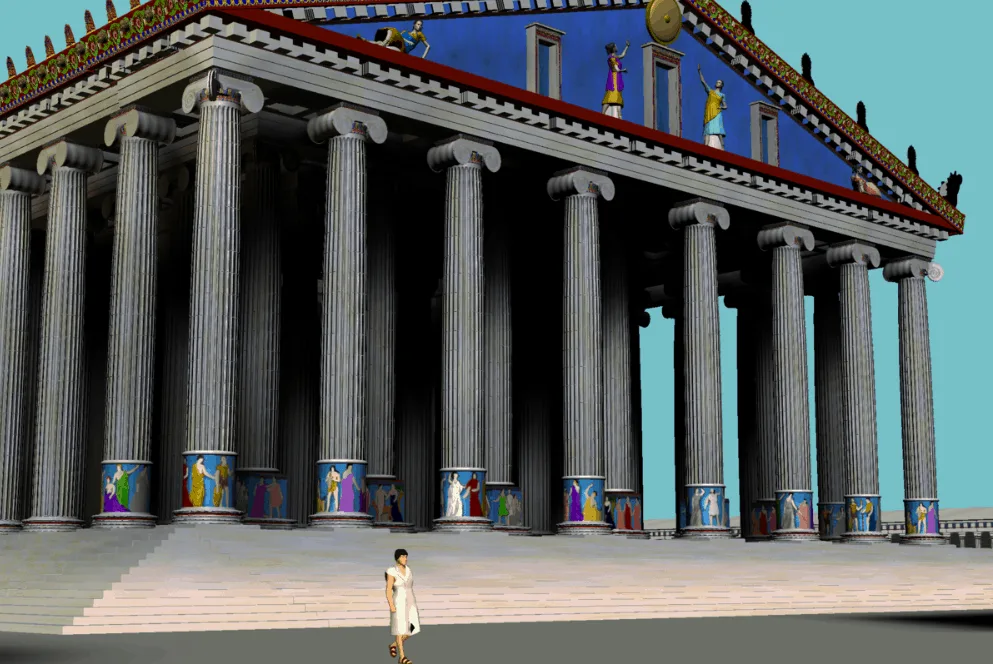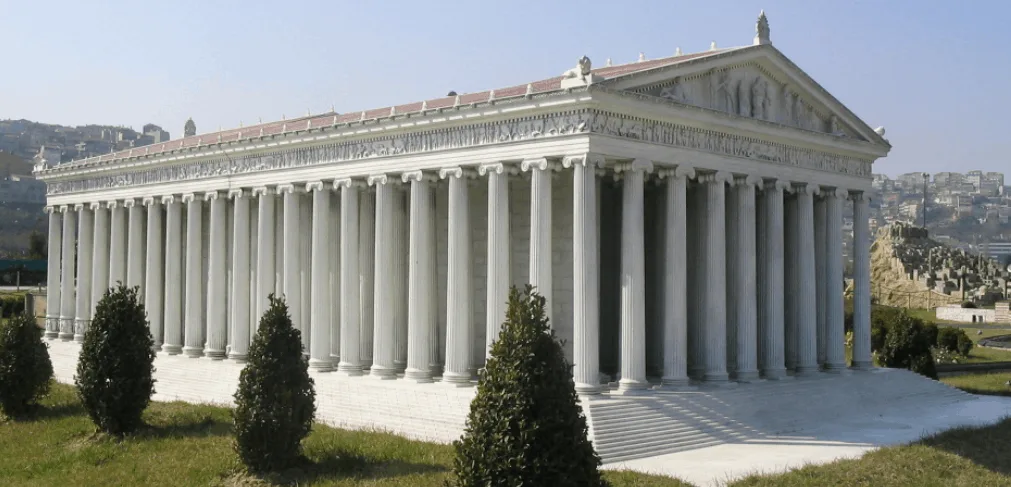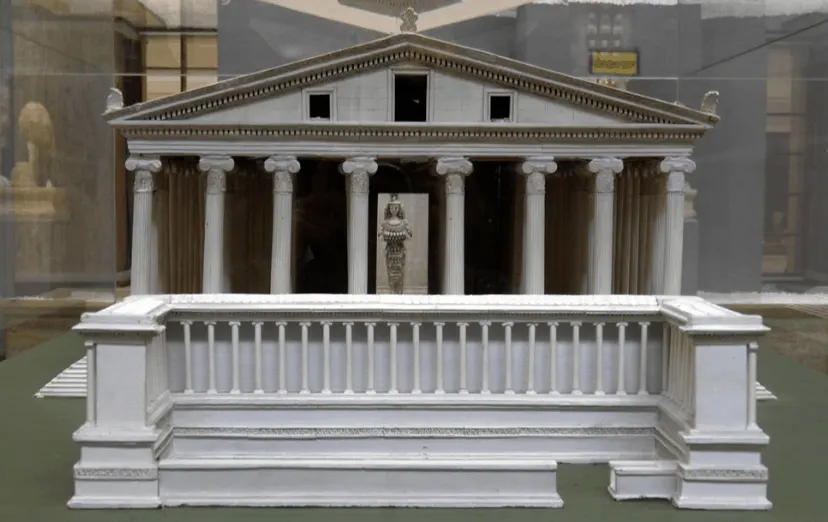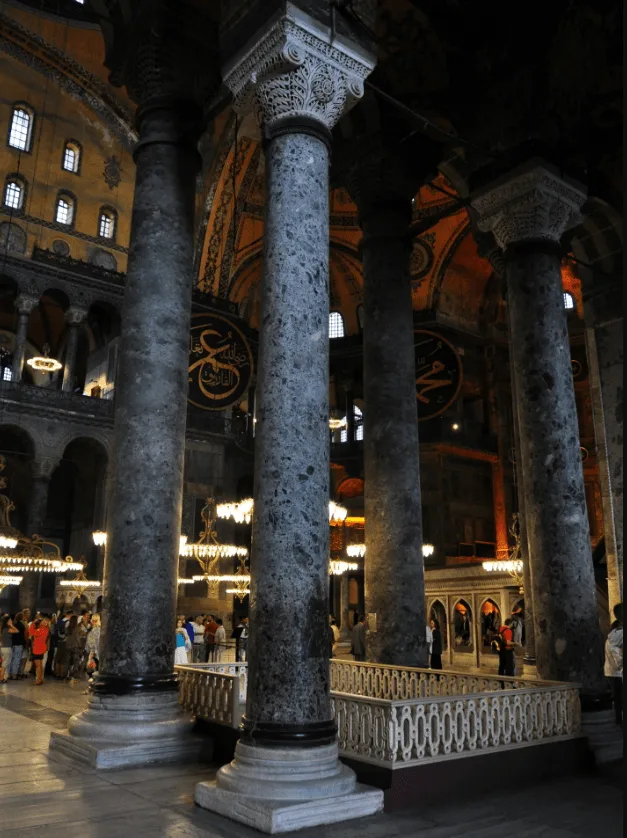One of the most beautiful Greek temples of the ancient world was located in Ephesus.
Ephesus was an ancient Greek city that was located in what is today Selcuk in the southwestern part of Turkey.
The temple was dedicated to a local version of the goddess Artemis which is associated with the Roman goddess Diana. That’s why the temple is also referred to as the Temple of Diana.
The temple is considered to be one of the 7 wonders of the ancient world, and in this post, you’ll discover all the facts about the Temple of Artemis at Ephesus.
1. Who was The Goddess Artemis
Artemis was a Greek goddess and the daughter of the daughter of Zeus and Leto and the twin sister of Apollo.
She was the goddess of the hunt, the wilderness, wild animals, the Moon, and chastity, and the Roman goddess Diana was her equivalent.
She was one of the most honored goddesses in ancient Greece and proof of this lies in the fact that an amazing temple was built for her.

2. The temple was destroyed by a flood
The first version of the Temple of Artemis is believed to have been built in the second half of the 8th century B.C.
The first version of the temple was a peripteral temple (meaning a temple surrounded by columns) and was most probably the first of its kind in all of Greece.
In the 7th century B.C. the temple was destroyed by a flood and left in ruins for at least 150 years.

3. The second temple was much bigger
The rebuilding of the temple started in 550 B.C. and took about 10 years to complete. It was the first Greek temple ever to be built with marble.
The second version of the Temple of Artemis was much more grandiose than the first one. The columns stood 13 meters (40 ft) high in double rows, at least 36 of them decorated with reliefs honoring the Gods.
The Temple was an enormous construction and was 115 meters (377 ft) long and 46 meters (151 ft) wide, which was about 4 times bigger than the first version.
To give a clear picture, this is about as big as a football/soccer field!

4. The temple was destroyed by fire
The Temple of Artemis has been described by anything that laid eyes on it as one of the most beautiful creations they ever witnessed.
One man named Herostratus thought to attain everlasting fame by destroying it, so he set the wooden roof beams on fire.
Apparently, this happened on the exact day that Alexander the Great was born, namely August 21 in the year 356 B.C.
He was tortured and executed and in an attempt to ensure he wouldn’t succeed in his plan to attain glory, anybody who even spoke his name would be condemned to the same faith.
Interesting fact: The term “Herostratic fame” refers to this incident and means “trying to achieve glory at any cost.”

5. The final version was self-funded
Alexander the Great offered to fund the rebuilding of the temple, but the Ephesians refused.
Instead, they funded the final version themselves and construction started in 323 B.C.
The final version of the temple was even bigger than the previous one and was 137 m (450 ft) long by 69 m (225 ft) wide and 18 m (60 ft) high. It also contained more than 127 columns.

6. It was considered to be the most impressive of the 7 wonders
Antipater of Sidon, an ancient Greek poet that lived in the second century B.C. was one of the first ones to come up with a list of wonders of the world. Others include Philo of Byzantium, Strabo, Herodotus, and Diodoros of Sicily.
He was so impressed with what he saw that he wrote the following regarding the Temple of Artemis at Ephesus.
I have set eyes on the wall of lofty Babylon on which is a road for chariots, and the statue of Zeus by the Alpheus, and the hanging gardens, and the Colossus of the Sun, and the huge labour of the high pyramids, and the vast tomb of Mausolus; but when I saw the house of Artemis that mounted to the clouds, those other marvels lost their brilliancy, and I said, ‘Lo, apart from Olympus, the Sun never looked on aught so grand.’
Considering that he laid eyes upon just about all of the other wonders of the ancient world, his words surely mean something.

7. The final destruction of the Temple of Artemis
According to historian “Jordanes,” the Goths, a Germanic tribe, set fire to and destroyed the temple of Artemis in 268 B.C.
To what extent the temple was destroyed is unknown. What is certain is that it was repaired and reused after that until the Christians permanently closed it, reportedly around the 5th century.
What exactly happened after is also unknown, but the might Temple of Artemis was eventually destroyed, and building materials were used for the construction of other buildings.
Some of the columns from the temples were used in the construction of the Hagia Sophia in Istanbul, Turkey.

More facts about the Temple of Artemis at Ephesus
8. It’s believed that the site where the Temple of Artemis used to be was already used as a sanctuary during the Bronze Age. One poet named Callimachus even attributed it to the Amazons in his “hymn to Artemis.”
9. After the temple was destroyed, it’s believed that the materials were used in building throughout all of Constantinople (modern-day Istanbul).
10. It took 6 years of searching to finally rediscover the Temple of Artemis back in 1869. The expedition was sponsored by the British Museum in London and led by John Turtle Wood.
11. Another excavation took place between 1904 and 1906 under the direction of David George Hogarth. A lot of the artifacts found during this expedition, mostly fragments of sculptures, can now be viewed in the “Ephesus Room” of the British Museum.
12. All that remains now at the site are some fragments and foundations of the original temple and a column that still stands.




Leave a comment
You must be logged in to post a comment.